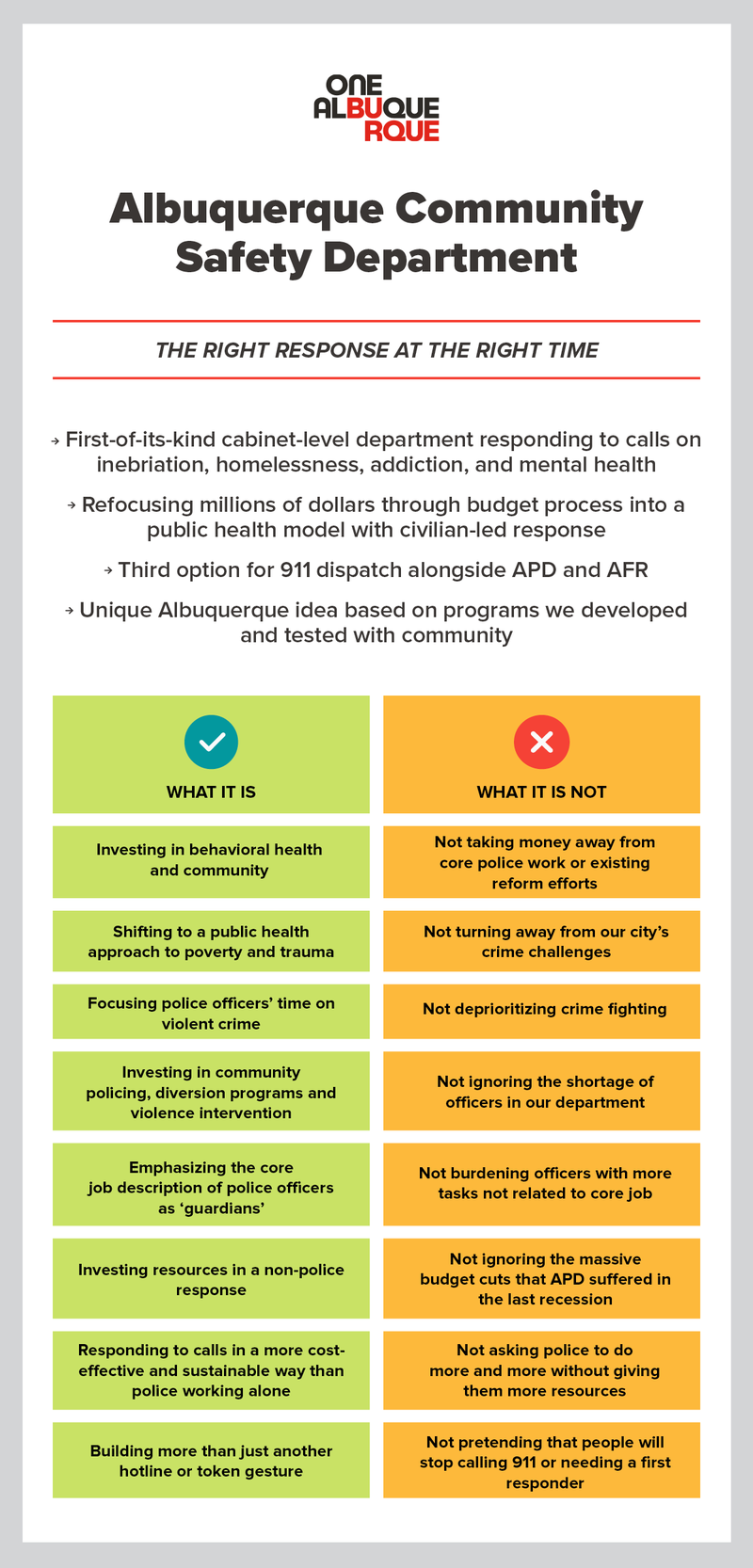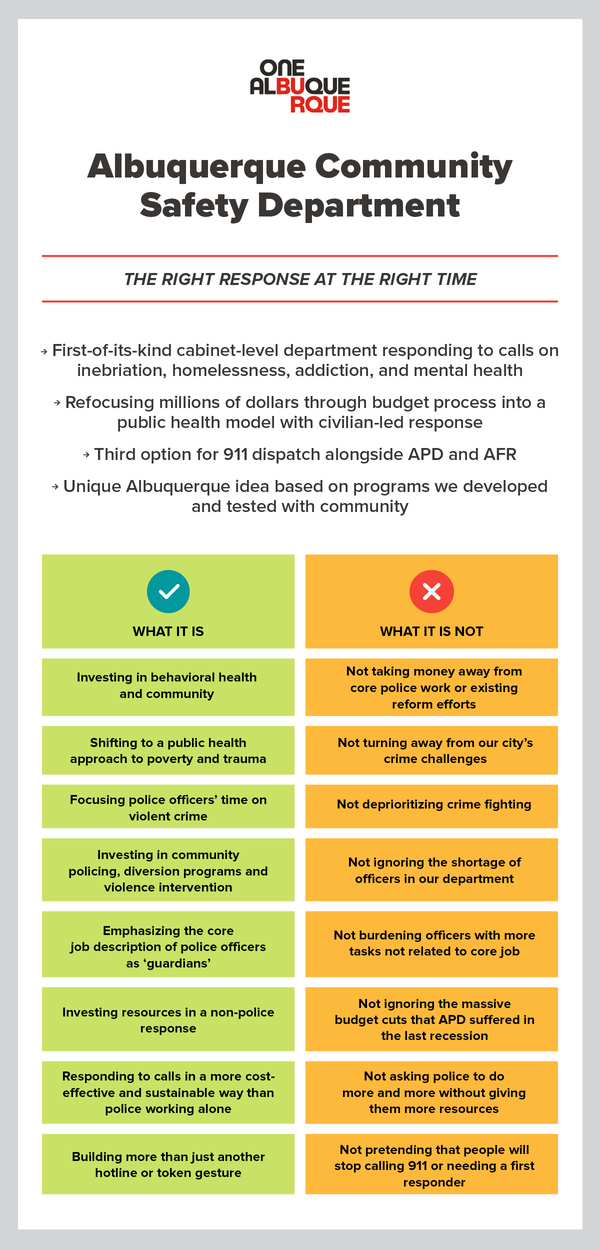
Mayor Tim Keller to Refocus Millions in Public Safety Resources with First-of-Its-Kind Civilian Response Department
Albuquerque Community Safety department will restructure thousands of calls on homelessness, addiction and mental health into the hands of trained professionals; keep officers focused on core police work and reform efforts.
June 15, 2020
In a groundbreaking first that puts our community at the forefront of a national conversation on public safety, Mayor Tim Keller announced today that he is creating a third department of first responders at the City of Albuquerque. Albuquerque Community Safety, a cabinet-level department, will serve alongside the Albuquerque Police Department and Albuquerque Fire Rescue to deliver a civilian-staffed, public health approach to safety. The new department is the culmination of two years of preliminary work to change the way Albuquerque handles public safety, and comes amid nationwide calls to move resources away from armed police response as a one-size-fits-all answer.
Albuquerque Community Safety (ACS) will include trained professionals such as social workers, housing and homelessness specialists, violence prevention and diversion program experts. The department will give 9-1-1 dispatch an option when a community safety response is more appropriate than a paramedic, fire-fighter, or armed police officer. The City will be working with community members, experts and City Councilors over the next two months to map out the details of the department, which will reallocate millions of dollars. These efforts will bolster expanded investments in violence intervention, diversion programs and treatment initiatives.
“While many cities are only now waking up to these issues, Albuquerque is well into its police reform process and we decided to tackle these tough questions head on when we took office. For years, we’ve heard the public calling for a better solution for de-escalation and more officers for community policing, and we have been listening. It’s time we stop asking officers to do everything, and time we get people the help they need instead of sending armed officers to knock on their door,” said Mayor Tim Keller. “We’re creating a third branch of first responders – alongside our police and fire departments - to deliver a civilian public health approach to public safety. Through the Albuquerque Community Safety department, we’re creating an innovative model that reflects our city’s current situation. We want to send the right resource to the right call—especially where a social worker or trained professional can connect people with the services they need, instead of simply taking folks to jail or the hospital, which have been the only choices until now.”
Over the last two years, the City has been working to transform its approach to public safety. That process began with new leadership at the Police Department and embracing the process of DOJ reforms. The administration created a dedicated compliance department, reformed internal affairs investigations, overhauled department use of force policies, implemented cultural competency and ethical policing training, and launched violence intervention and diversion programs to keep young people out of the criminal justice system. The administration has also been focused on reducing gun violence, which is a key denominator in violent crime.
The City has been piloting the shift of some responses out of police and fire, including homeless encampment outreach and “down and out” calls. Mayor Keller also created the first Office of Equity and Inclusion and the Office of Civil Rights and invested millions annually in youth programs and infrastructure in parts of town that have been historically underserved.
Chief Administrative Officer Sarita Nair said, “Our community and our officers agree that some calls are more appropriate for non-police personnel equipped with the right resources and expertise. We’ve had some early successes innovating with new types of responses, including the more than 15,000 “down and out” calls we moved out of the Police Department over a year ago. The Albuquerque Community Safety department will continue to focus our resources more efficiently and effectively and is a key part of our response to the public calls for change.”
In a planning process that will take place over the next several months, the City will gather input from experts and the public on how to bring together this new department with resources currently spread across several areas, including Albuquerque Police Department, Albuquerque Fire Rescue, Family and Community Services, and the Department of Municipal Development.
When it begins operations, Albuquerque Community Safety department will help the City focus police efforts and resources on fighting violent crime, and fire fighters and paramedics on fires and medical emergencies. That should lead to decreased response times, as 9-1-1 dispatchers will have another tool in their toolbox to send trained professionals to respond to calls on homelessness, addiction, mental health, and other issues that do not present an immediate threat to public safety.
The Albuquerque Community Safety department will also more efficiently connect those in need with service providers that address underlying issues including housing or treatment for addiction and behavioral health. Just as the Albuquerque Fire Rescue department currently does, responders from the new department will call for police assistance if there is a threat to their own safety or the safety of others.
Albuquerque Police Department Chief Mike Geier said, “This new department will make Albuquerque safer. We have seen success when officers partner with behavioral health clinicians and social workers to address complicated cases involving people in crisis or child neglect and abuse. My officers are sent to a wide range of calls that do not need or benefit from a police response, and that takes away from time they could be doing community policing. Civilian expertise can make all the difference in resolving problems without the threat of arrest. And limiting the need for police involvement helps to build trust with the community and allow officers to focus on reducing crime.”
Albuquerque Fire Rescue Chief Paul Dow said, “It’s important to look at the system as a whole to ensure the right resources are being sent to the right calls. Based on early results on down and out calls, we already know this can make AFR more efficient and effective, and I expect ACS to help focus resources even further.”
Michelle Melendez, Director of the Office of Equity and Inclusion said, “The establishment of this new department acknowledges the mismatch between the social needs of people experiencing non-violent crises in our community and the existing infrastructure that attempts to respond to those needs. A social work response, rooted in social justice, gives us a much better chance of connecting people with the help they need and getting better outcomes for people of color without involving law enforcement.”
City Councilor Lan Sena said, “I appreciate the administration for shedding light on this idea that is good for Albuquerque in the face of national challenges. This is just the start of the process and as a Councilor, I am committed to helping bring this to life through the upcoming budget process. The unique challenges that our city face require a nuanced approach that extends beyond the political rhetoric that can often be divisive; however, the issues at hand are more important than what drives us apart. This idea allows us to bring in community to have the important discussion and listen to their lived experiences while taking action to make a difference. We look forward to working together on this fundamental shift to our approach to public safety.”
To support this new approach to community safety, the City has initiated conversations with educational institutions to build a pipeline to hire the trained professionals who are needed in exchange for education funding or student loan repayment.


